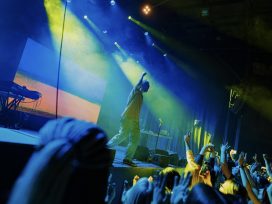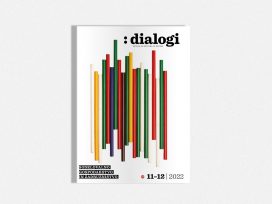Promoting the city and culture
For a while now I’ve been looking over our introductory editorials and wondering whether we’ve perhaps overlooked some cultural topic. Some subjects we’ve broached have been the importance of the cultural capital, an art cinema, issues relating to artists and their rights… as I sift through these, I don’t see any missing topics but rather am led to the realization that, despite all our warnings and efforts, nothing has changed in Maribor. For example: there is still no art cinema in the city, renovation of the castle has been slow and fraught with complications, the art gallery is still waiting for storage space and space for modern art, the puppet theatre still needs a new theatre, planning for the Pekarna complex has completely stalled, the arts academy is also on hold… the upshot of all this is that the city of Maribor has neither a suitable museum nor a gallery, and any number of cultural and artistic activities take place in substandard conditions. One can only conclude that there is a lack of will, and that the city organizes just enough to hide the fact that there is nothing really happening. Who is responsible for the lack of vision and conviction? Since the city leadership has changed, I wouldn’t lay the blame on the city leaders and their visions. Better to look elsewhere – for instance, at the tourism sector and the degree of cultural visionariness to be found there.
Let’s take a look at Maribor’s official tourism website. Right at the outset, our tourism association informs the visitor, in response to the question “Why come to Maribor?”, that Maribor is worth a visit because of its hilly wine-growing regions, the forests on Pohorje, the glittering waters of the Drava River, the oldest grapevine in the world, and a world-class events calendar. Each of these mentions carries a link to a site describing Maribor’s special features in even greater detail. Climate, geology, the attractions of the Pohorje mountain range and the Drava River are all described, as is the Maribor grapevine and its listing in the Guinness Book of World Records. Surprisingly, the events calendar and social pages offer very little that could be considered “cultural”. The first mentions only a few small exhibitions in the Bolfenk Church, and the second finds nothing in the cultural pulse of the city to capture the interest of potential visitors to Maribor. Once again, the city’s tourism association finds reasons for a visit only in the wine-growing hills, in the opportunity to exchange glances over glasses of wine, in the love of wine and Styrian beer; a few other characteristics of the city, such as the “rivalry with Ljubljana” and football, are also mentioned. The accompanying photos reinforce the text: football fans wearing purple scarves and couples dancing in folk costume are offered as representative of Maribor residents. A site providing space for a detailed description of the rocks of the Pohorje range is unable to find anything cultural to offer the internet tourist!
The potential tourist would likely conclude that Maribor is known mainly for its beautiful natural surroundings. He would also likely wonder what is wrong with a city where so little is happening and the exhibitions mentioned qualify as its only top-class events. Agreed, residents of Maribor can consider themselves fortunate that their city offers close proximity to the Pohorje region and beautiful walks along the Drava River. The grapevine is also something special. And football, folklore, and wine-drinking are pleasant activities. But where are all the cultural and artistic events? Some of us are convinced that culture does exist in the city, and that it is at least as important and interesting as the wine-growing hills. We could further ask how it could have happened that the tourist association has completely overlooked this cultural activity. And also why the majority of comparable cities advertise and promote themselves in a completely different way. Even if nothing is written in the first key phrases about the existence of the city’s cultural and artistic activities, in the majority of cases some cultural event is hailed on the first page. Why does Trieste’s web page prominently highlight the film festival at the top of its large frame? Why does the official tourism page of Graz look completely different from Maribor’s? Of the six items currently featured on the page, all are associated with culture and art: a film and music festival, a Japanese cultural festival, an exhibit in the children’s museum, a video event, and a listing of events during the advent season. How does the Austrian city of Graz differ so greatly from Maribor?
A shining exception to the usual offer on the Maribor site was the news in mid-October about the Borstnik meeting (a theatre festival). But where were the events of Musical September (a two-week music festival in September), where was the mention of the exhibitions in the KiBela Space for Art and the Art Gallery? It would also have been interesting to promote the city in the photographic spirit created by the Maribor Photography Club on the occasion of its anniversary. Not to mention a listing for the documentary film festival DoKma and the exceptional and high-quality jazz festival Izzven. In the section on the city’s atmosphere there could also be something from the modern scene, at the very least the singers from the world-class choir Carmina Slovenica or intriguing scenes from the choreography of Edvard Clug. Of course it’s true that the tourism pages also cover culture. We find it hidden in the section Experiences – Culture, where all the cultural institutions are listed. Similarly, we can look for it in the abundance of diverse information, often jumbled, incomplete, and full of inaccuracies – if we feel like clicking at least four times on various links in order to get to the listing of current events.
So, how would someone looking at its website see the city of Maribor? Certainly not as a city of culture. If we are to believe the web pages, we would conclude that the city has no idea what to do with culture. It has to list it and have it because someone somewhere heard that this is the right thing to do. The city is not even aware of what it would be interesting to offer tourists. Even further from its mind is that culture indicates the degree of creativity of a given environment. History attests to the continuity and durability of creativity, and modernity fertilizes the space with ever new possibilities. There exist a large number of dispersed events but what is lacking is an awareness of their importance and any recognition of their quality.
Can the tourism sector reveal the attitude of the city towards culture? Can a tourism page reveal the extent of the city’s visionariness? Fortunately we’re talking only of a web page, which, given sufficient good will, can be changed in a few days. But what about the cultural vision of the city?!
Published 26 November 2006
Original in Slovenian
First published by Dialogi 10/2006 (Slovenian version)
Contributed by Dialogi © Breda Kolar Sluga/Dialogi Eurozine
PDF/PRINTNewsletter
Subscribe to know what’s worth thinking about.



